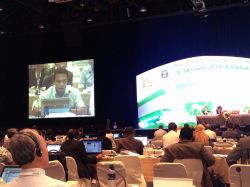 An enormous inflatable manta ray welcomed hundreds of attendees and key delegates from nations around the world to the Manta Ray of Hope event at the 16th meeting of the Convention on International Trade in Endangered Species of Wild Fauna and Flora (CITES).
An enormous inflatable manta ray welcomed hundreds of attendees and key delegates from nations around the world to the Manta Ray of Hope event at the 16th meeting of the Convention on International Trade in Endangered Species of Wild Fauna and Flora (CITES).
The event, organized by the Manta Ray of Hope team and Thai conservation organization Freeland, in cooperation with the Tourism Authority of Thailand, was part of the Shark Savers’ and WildAid’s successful Manta Ray of Hope campaign that included a PSA featuring Richard Branson and two short films, Mantas Last Dance” and “Manta Ray of Hope: The Global Threat to Manta and Mobula Rays” aimed at informing delegates and underscoring the urgency of the proposal to regulate the international trade in manta gill plates.
The representative from Tourism Authority of Thailand, who spoke at the event, highlighted the importance of manta rays to Thailand’s multi-million dollar dive industry, and Emcee Piyada “Jaime” Monmanerat, Miss Scuba International, underscored this fact by sharing her personal dream to one day dive with a manta.
Ecuadorian delegate, Eduardo Espinoza, explained his country’s reasons for sponsoring the manta proposal, and asked other countries to join Ecuador, Brazil and Colombia, and the many other countries who had already pledged their support. Two of the world’s top manta scientists, Marine Megafauna Foundation’s, Dr. Andrea Marshall, and Guy Stevens from the Manta Trust spoke about manta rays’ extreme vulnerability and the dramatic declines in manta ray populations, with manta rays targeted by fisheries in an area studied by Dr. Marshall declining by 87% over only 8 years.
 “We received extremely positive feedback from the delegates and the attendees,” says Shawn Heinrichs, Project Co-Lead of Manta Ray of Hope. “We were able to provide delegates with the information they needed about the urgent threats that mantas face.”
“We received extremely positive feedback from the delegates and the attendees,” says Shawn Heinrichs, Project Co-Lead of Manta Ray of Hope. “We were able to provide delegates with the information they needed about the urgent threats that mantas face.”
On the day of the vote 5 days later, however, it was still not certain if the proposal would pass. Both Japan and China spoke in opposition of the proposal, claiming a lack of science to support the listing.
But there was a pleasant surprise. “We were thrilled to hear a supporting statement from Mozambique, who had been undecided until soon before the vote,” says Project Co-Lead Mary O’Malley. “Thailand also spoke up in support of the manta proposal, even though they had spoken in opposition to the Oceanic Whitetip and Hammerhead Shark proposals, and the Jakarta Post had reported a few days prior that Thailanad would oppose all the shark and ray proposals.”
The United States, Australia, New Zealand, Ireland, on behalf of the EU, and several Latin American countries all spoke in favor of the proposal.
 Because the day was almost over, the Chair agreed to take only one non-governmental organization (NGO) intervention: a small group from Brazil called Divers for Sharks. Paulo Pinguim’s heartfelt plea as a small business owner representing other small dive operators throughout the world was inspiring, asking the delegates to respect the livelihoods of those whose businesses depend on manta rays and to save their jobs.
Because the day was almost over, the Chair agreed to take only one non-governmental organization (NGO) intervention: a small group from Brazil called Divers for Sharks. Paulo Pinguim’s heartfelt plea as a small business owner representing other small dive operators throughout the world was inspiring, asking the delegates to respect the livelihoods of those whose businesses depend on manta rays and to save their jobs.
The proposal passed the Committee I vote with 80% of the delegates in favor, and was approved by consensus in the final Plenary session on March 14th, officially including both Oceanic and Reef Manta rays on Appendix II of CITES, the only binding international treaty regulating international trade in threatened species.